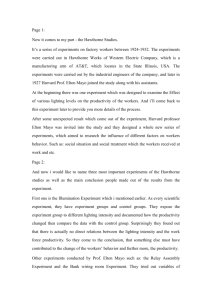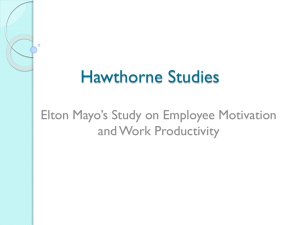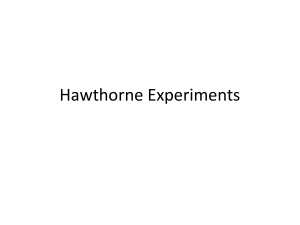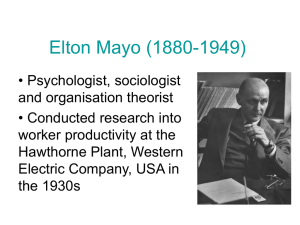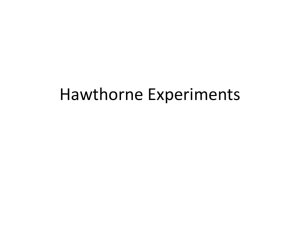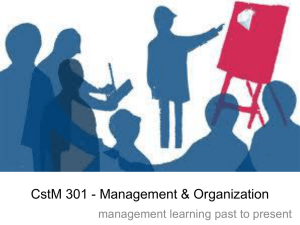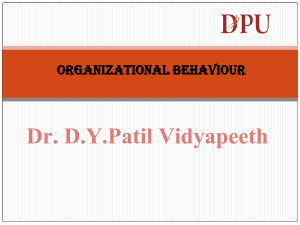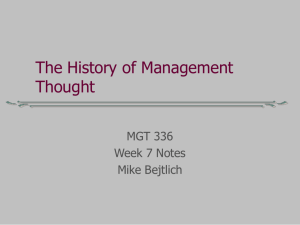Hawthorne Experiments
advertisement
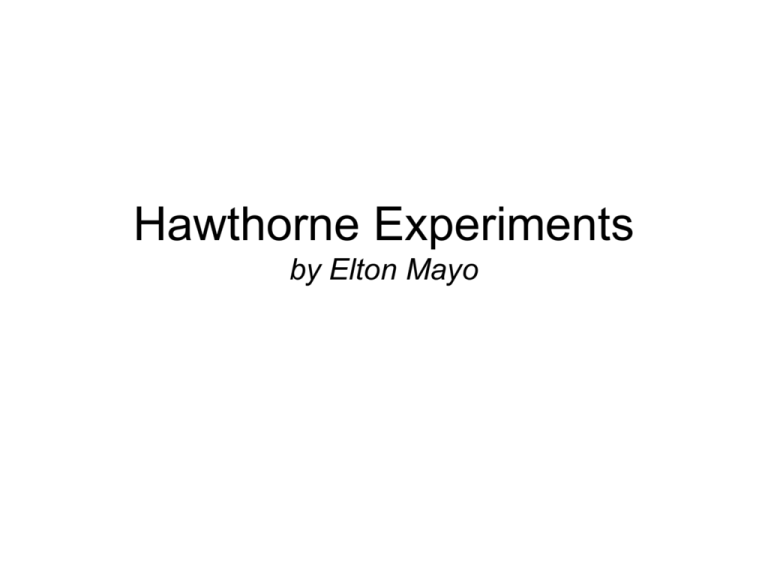
Hawthorne Experiments by Elton Mayo Illumination Studies – 1924-1927 • Funded by General Electric • Conducted by The National Research Council (NRC) of the National Academy of Sciences with engineers from MIT • Measured Light Intensity vs. Worker Output • Result – Each change (including decreases) resulted in higher output and reported greater employee satisfaction • Conclusions: – Light intensity has no conclusive effect on output – Productivity has a psychological component – Researchers interaction with the workers influenced higher performance • Concept of “Hawthorne Effect” was created Relay Assembly Test Experiments 1927-1929 • Western Electric wanted more information • Harvard researchers brought in to analyze the results – Elton Mayo & Fritz Roethlisberger • Group of 6 Women – (5) Assemblers and (1) Layout Operator • One Observer – Explained every incremental change and recorded results • Manipulated factors of production to measure effect on output: – – – – Pay Incentives Length of Work Day & Work Week Use of Rest Periods Company Sponsored Meals • Management Visits / Special Attention • Result – Most changes resulted in higher output and reported greater employee satisfaction • Conclusions: – Experiments yielded positive effects even with negative influences – workers’ output will increase as a response to attention – Strong social bonds were created within the test group. Workers are influenced by need for recognition, security and sense of belonging Relay Assembly Room #2 - 1928-1929 • Measured output changes with pay incentive changes – Special observation room – Relay Assemblers changed from Departmental Incentive to Small group – 1st Session – Adjusted back to Large Group Incentive – 2nd Session • Results – Small Group Incentive resulted in new Highest sustained level of production – 112% over standard output base – Output dropped to 96.2% of base with return to large group incentive • Conclusion: Pay incentives were a relevant factor in output increases but not the only factor. Mica Splitting Test Group - 1928-1931 • Measured output changes with changes in work conditions only: – – – – Special Observation Room Length of Work Day Use of Rest Periods Workers stayed on established Piece-rate compensation • Result - Productivity increased by 15% over standard output base • Conclusions: – Productivity is affected by non-pay considerations – Social dynamics are a basis of worker performance Plant Interview Program – 1925-1932 • 1925-1927 – Objective Questions – Work Conditions – Work Relationships – Yes/No Answers • 1928-1932 – Conversational / Non-directive – Attentive Sympathetic Listening – Concern for personal needs – Increased in time from 30-90 minutes • Result – Remarkable positive employee perceptions: – Working Condition Improved (no real changes) – Better Wages (no real changes) • Conclusions: – New Supervisory Style improved worker morale – Complaints reflected personal and/or social barriers that needed attention in order to raise productivity Bank Wiring Observation Group – 1931-1932 • 14 Male Workers • Few Special Conditions – – – – Segregated work area No Management Visits Supervision would remain the same Observer would record data only – no interaction with workers • New incentive pay rate was established for the small group • Any increases in output would be included in departmental pay incentives • Result – No appreciable changes in output • Conclusions: – Well established performance norms existed in the group – Informal Social Organization dictated little deviation from established production standards – Systemic Soldiering – Informal Social Organizations protect workers from managers who • Raise production standards • Cut pay rates • Challenge workplace norms Sources of Information • Wren, Daniel A., and Arthur G. Bedeian. The Evolution of Management Thought. 6th ed. Hoboken, NJ: John Wiley & Sons, Inc., 2009. Print. • "History of Management." ManagementGuru supports management studies and is maintained by Dr.Makamson. Web. 16 Nov. 2009. <http://www.mgmtguru.com/mgt301/301_Lecture1Page10.htm>. • "Baker Library Chronicles Human Relations Movement." Harvard Business School. Web. 16 Nov. 2009. <http://www.hbs.edu/news/releases/092407_hawthorne.html>. • "ProvenModels hawthorne effect - Elton Mayo." ProvenModels - Management Models | Management Theory | Business Models | Michael Porter | Henry Mintzberg | Management Model | Business School. Web. 15 Nov. 2009. <http://www.provenmodels.com/6/hawthorne-effect/elton-mayo>.
